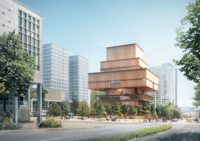National Register of Historic Places Recognizes Two Post-War Parks








Two modernist parks joined the National Register of Historic Places (NRHP) this month, boosting the often uphill battle to preserve America’s important post-war landscapes. Gas Works Park in Seattle, designed by Richard Haag, and Peavey Plaza in Minneapolis, designed by M. Paul Friedberg, have won official recognition.
“These two landscapes are now part of an august group of seminal works of landscape architecture,” says Charles Birnbaum, President of the Cultural Landscape Foundation (TCLF), a non-profit organization dedicated to raising awareness and understanding of America’s landscape heritage. Each park represents “the work of a master in a seminal project, and a pioneering effort in its typology." Of more than 88,000 sites listed on the National Register, only some 2,300 are less than 50 years old, and of those, scarcely more than 200 have been classified as landscape architecture. According to Birnbaum, the listing of these two relatively young parks testifies to their exceptional significance, and to a surging knowledge and interest in landscape over the last 20 years.
Gas Works Park opened in 1975 on the site of a former coal gasification plant on the shores of Lake Union. Haag, a two-time recipient of a Presidential Award for Design Excellence from the American Society of Landscape Architects (ASLA), broke new ground with the project, both in reclaiming an industrial site through soil bioremediation, and in honoring the importance and eerie beauty of the site’s industrial artifacts.
Friedberg, the 2004 recipient of ASLA’s highest honor, the Design Medal, is recognized as the originator of the park plaza typology. Peavey Plaza, which also opened in 1975, integrates the hardscape of the European plaza and the greenery of the American park to create an urban oasis, and is considered the finest surviving example of Friedberg’s work from the period.
Surviving, however, has proven a challenge for many modernist landscapes, Peavey among them. Neglect and deterioration, combined with issues of security and accessibility, have led the City of Minneapolis to conclude Peavey’s day is done. “Yesterday’s listing does not impact the path the City is on regarding proposed demolition and renovation of Peavey Plaza,” writes Matt Lindstrom, spokesperson for the City ofMinneapolis. The park is the subject of litigation by advocates for it rehabilitation. While the National Register listing does not offer outright protection, in order to proceed with demolition of a listed property, the City of Minneapolis’s Heritage Preservation Ordinance requires a finding that there are “no reasonable alternatives.”
Two more modernist landscapes, Lawrence Halprin’s Open Space Sequence in Portland, Oregon, and Garrett Eckbo’s Tucson Community Center in Arizona, are now making their way through the NRHP nomination process.








